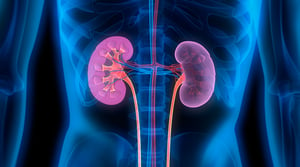Morbidity and Mortality in Patients with CKD
(Gleaned from the 2018 USRDS Annual Data Report: Volume 1, Chapter 3: www.usrds.org)
Mortality in patients with CKD is a major outcome and concern. For patients with CKD, the unadjusted mortality rate in 2016 was 122.6 per 1,000 patient-years; this decreased to 103.0 per 1,000 patient-years after adjusting for age, sex, and race (standard population: 2016).
Mortality rates increased as age increased, particularly in the oldest cohort. Among CKD  patients, those aged 66-69 years had a mortality rate of 60 deaths per 1,000 patient-years at risk, while those aged 75-84 had nearly double that, at 104 deaths. As also might be expected, patients aged 85 and older experienced the highest rates of mortality, with 236 deaths per 1,000 patient-years. As expected, the mortality rates for those in higher CKD stage groups were higher.
patients, those aged 66-69 years had a mortality rate of 60 deaths per 1,000 patient-years at risk, while those aged 75-84 had nearly double that, at 104 deaths. As also might be expected, patients aged 85 and older experienced the highest rates of mortality, with 236 deaths per 1,000 patient-years. As expected, the mortality rates for those in higher CKD stage groups were higher.
In all cases, male patients had slightly higher mortality rates than females, and even more so for those with CKD.
Hospitalization
Across all demographic characteristics, the 2016 unadjusted hospitalization rate for patients with CKD was about twice the corresponding rate for patients without CKD. Once the adjustment was made for age, race and sex, the hospitalization rate for Medicare patients with CKD of 568.0 per 1,000 patient-years at risk was 147.0% greater than for those without CKD, at 230.
- Adjusted hospitalization rates declined from 2015 to 2016 in both CKD and non-CKD patients. The decline was greater for CKD patients than for patients without CKD in both populations
- Not surprisingly, among Medicare patients, after adjustment for sex and race, rates of hospitalization in older patients were greater than for younger age cohorts. In the CKD group, hospitalization rates for those over 85 years was 39.7% higher than among those aged 66 to 69 years: 706.2 vs. 505.4 admissions per 1,000 patient-years at risk.
- Racial differences in Medicare hospitalization rates were notable. In both the CKD and non-CKD populations, Black patients were hospitalized more frequently than those of other races. In 2016, Black patients with CKD showed higher rates than did Whites or those of other races, at 652 per 1,000 patient-years versus 568 for Whites and 471 for other patients. This disparity decreased with disease severity; rates for Black patients were 5.0% higher than Whites in Stages 1-2 (508 vs. 484), 10.4% higher in Stage 3 (626 vs. 566) and 21.3% higher in Stages 4-5 (1,037 vs. 855). Patients of other races experienced the lowest rates of hospitalization in all disease stages.
Hospitalization Readmissions within 30 Days of Discharge
Hospital readmissions are a key quality indicator for the Medicare program. In an attempt to lower the rate of readmission, the Medicare Hospital Readmission Reduction Program was instituted as part of the Patient Protection and Affordable Care Act (CMS, 2010), to reduce Medicare payments to hospitals with excess readmissions. Patients (21.6%) with CKD are readmitted more frequently than those (15.3%) without diagnosed CKD. In Medicare patients without CKD, males exhibited a higher readmission rate than did females, with age and race adjusted percentages of 16.2 and 14.6.




